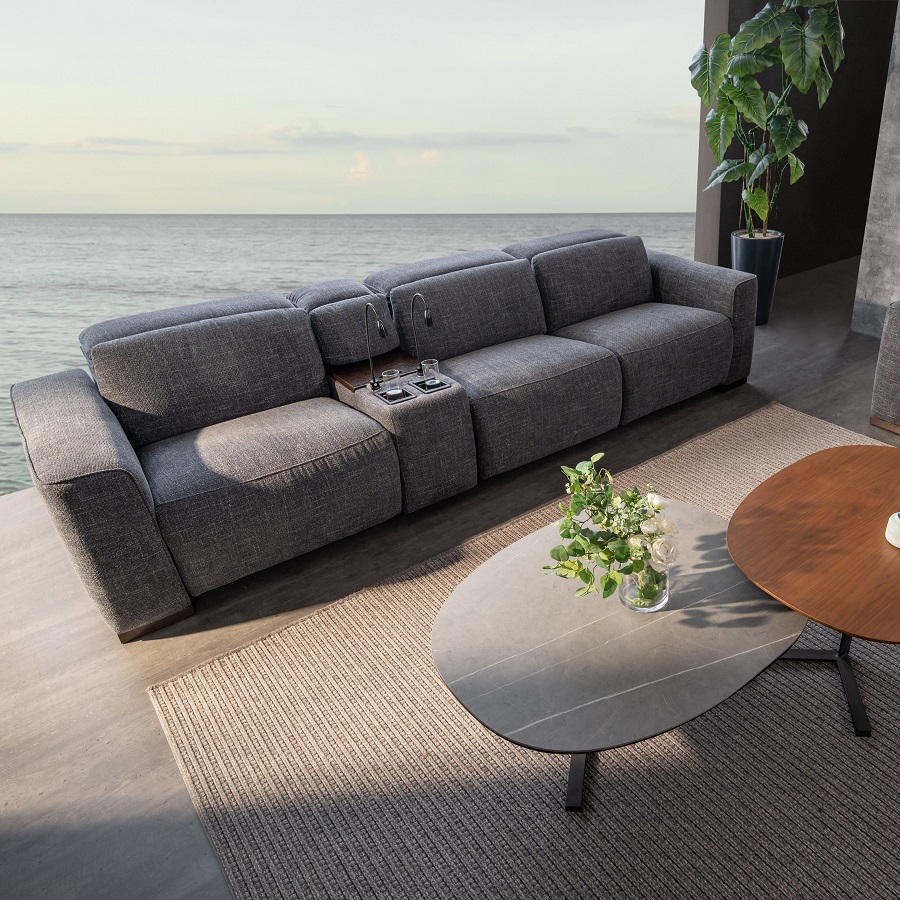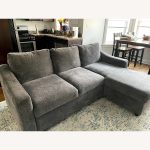Introduction to Sofa Sizing
When embarking on the journey of selecting a new sofa, size matters. Not only does the size need to fit harmoniously within your living space, but it also should cater to the comfort and requirements of those who will be using it. The perfect sofa serves as a functional fixture and enhances the aesthetic appeal of your room. With various styles and sizes available, understanding sofa dimensions is key to making an informed decision.
From traditional three-seater sofas to compact loveseats and expansive sectional designs, the options are plentiful. A standard sofa depth is significant for providing the right level of comfort while also fitting neatly into your living area. It’s essential to consider both the overall dimensions and the specific sizing of different components, such as depth, which can vary to cater to different seating preferences.
Whether you reside in a snug apartment or a house with ample living space, selecting a sofa with suitable dimensions is crucial. The quest for the perfect sofa encompasses more than a cursory glance at its style or seating capacity. It involves understanding its dimensions and how it will occupy your space, both in terms of size and its collaborative role with other room furnishings.
In your search for that ideal sofa, you’ll come across various terminologies like sofa length, width, height, and depth. Each parameter contributes to the overall functionality and aesthetic of a sofa. By delving into these key dimensions, you’ll be equipped to find a sofa that not only looks great but also provides the ultimate comfort for your day-to-day living.

Key Sofa Dimensions Explained
Selecting the right sofa involves more than just picking out a style you like. Understanding key dimensions like length, depth, and height is essential. Let’s dive into the specifics to help you choose the perfect sofa for your home.
Sofa Length or Width Variations
When you’re sofa shopping, the terms length and width might be used interchangeably. Generally, a three-seater sofa ranges from 73 to 87 inches from one armrest to the other. The size you choose depends on your room size and seating needs.
Importance of Sofa Depth for Comfort
Sofa depth can greatly affect your comfort. On average, a standard sofa depth is 34 to 40 inches from the front edge to the back. A deeper sofa means more space for lounging, but consider the height of the users for optimal comfort.
Standard Sofa Height Parameters
The height of a sofa, measured from the floor to the top of the backrest, typically ranges from 30 to 35 inches. A sofa with the right height ensures a comfortable backrest that aligns well with other room elements.

Loveseat Dimensions Overview
Understanding the dimensions of a loveseat is essential for ensuring it fits your space and meets your needs. A loveseat is essentially a smaller sofa designed to seat two people comfortably. Its compact size makes it an ideal choice for smaller living areas or as a complement to a larger sofa in a spacious room. Here, we delve into the typical measurements of a loveseat and why these might matter to you.
Loveseat Size Range
The typical width of a loveseat spans from 56 to 72 inches. This measurement is from one armrest to the other. The depth, or the distance from the front edge to the backrest, usually falls between 34 to 40 inches.
Seat Height and Depth
Most loveseats have a seat height ranging from 17 to 20 inches. This is from the floor to the top of the seat cushion. The seat depth, or the distance from the front edge of the seat to the backrest, typically varies from 20 to 24 inches.
Total Height
On average, a loveseat’s height, which is measured from the floor to the top of the backrest, will be around 30 to 35 inches. It’s essential to consider the total height to ensure it pairs well visually with other furniture and allows for comfortable back support.
Space Planning
When planning to incorporate a loveseat into your space, it’s important to allow for walking room and space for other furniture. A good rule of thumb is to have at least 18 inches of free space around the loveseat. This allows for easy movement and a balanced look.
Choosing a loveseat involves not only considering its style and material but also being mindful of its dimensions. Make sure your space can accommodate the loveseat’s width, depth, and height. Don’t forget to consider the seat height and depth to ensure a comfortable seating experience. With these measurements in mind, you’ll be well on your way to selecting a loveseat that’s a perfect fit for your home.
Understanding Sectional and Modular Sofas
Sectional and modular sofas offer versatility and style. Understanding their unique features can help tailor your living space to your needs.
Special Features of L-Shaped Sofas
L-shaped sofas provide a distinctive advantage for corner placements. The L-shape optimizes seating without consuming excess space, making it ideal for both small and large rooms. Typically, an L-shaped sofa ranges from 90 to 150 inches in width and 60 to 95 inches in depth. This layout invites social interactions and offers an unobstructed view of the room.
Modular Sofa Configurations
Modular sofas excel in adaptability. They consist of multiple sections that can be rearranged to fit any room layout. Measurements for modular sofas include a width of 20 to 35 inches per section, with similar depths as conventional sofas. Combinable sections can stretch lengths from 70 to 210 inches depending on arrangement. These sofas are perfect for those who appreciate flexibility in furniture layout. Their ability to morph as needed is especially useful for frequently redesigned spaces or multi-purpose rooms.

Sofa Beds and Sleepers: Functional Dimensions
standard sofa beds and sleepers add versatility to home furnishings. They double as comfortable seating and transform into beds. Ideal for guests or small spaces, knowing their dimensions is key for a perfect fit.
Understanding Sofa Bed Sizes
Sofa bed sizes vary, from twin to queen. A twin might measure around 54 inches wide, while a queen can be up to 84 inches. Depth ranges similar to standard sofas, 34 to 40 inches. Measure space for both sofa and bed forms.
Sleeper Sofa’s Diagonal Depth
Measure the diagonal depth for sleeper sofas. This is the space needed when it’s unfolded. Check this measurement to ensure a comfy fit for overnight stays. It avoids blocking walkways or other furniture when open.
Space Needed for Sofa Bed Extension
Consider the extra space required for the bed extension. Ensure the area allows the bed to extend fully without hindrance. It enhances usability and avoids frustration when converting from sofa to bed.
Keep Entryways In Mind
Account for entryways when choosing a sofa bed. Ensure your choice will pass through doors and hallways. Measure the clearance needed for a smooth move into your living space.
Having the right balance of functional dimensions ensures that you select a sofa bed or sleeper that’s not only a stylish addition to your room but also a practical choice for sleeping arrangements. Measure carefully, plan for usability, and enjoy the dual benefits these versatile pieces offer.
How to Accurately Measure Your Space for a Sofa
Before buying a new sofa, it’s critical to ensure it will fit in your space. Proper measurement avoids the headache of a sofa that’s too large or looks out of place. Our step-by-step guide provides all you need for precise measurements.
Tools and Techniques for Measuring
Start with a measuring tape, a notebook, and a pencil. Clear the area where you plan to place the sofa. Measure the length, width, and height of the space. Jot down these numbers. Mark the floor with painter’s tape to outline the sofa’s footprint. This visual aid helps to better judge the fit.
Planning for Entries, Passageways, and Room Layout
Measure doorways and passages the standard sofa must pass through. Include width, height, and any tricky angles or turns. Document the entry path to the room, noting any obstructions. Consider the room’s layout, ensuring there’s enough space for other furniture and walking paths around the new sofa.
Considering Viewing Distance for TV Placement
If your sofa faces a TV, calculate the ideal distance. The rule is 1.5 times the TV’s diagonal screen size. Measure from the TV to the area where you’ll place the sofa. This distance ensures comfortable viewing and adds to overall room comfort.
Shopping for the Perfectly Sized Sofa
Navigating the purchase of the right-sized sofa is a must for any home. By considering the specific dimensions recommended, coupled with your living space and personal preferences, you’re sure to find a piece that not only fits but also complements your overall home decor.
Selecting Sofa Styles for Different Room Sizes
Room size dictates sofa choice. For small spaces, choose compact options like loveseats or two-seaters. Larger rooms can handle sectionals or modular sofas with ease. Always allow for walking space and room balance.
Material Choices and Durability Considerations
Sofa material affects both looks and longevity. Leather offers durability and ease of cleaning, while fabrics can be cozier and sometimes removable for washing. Consider lifestyle, usage, and who will use the sofa when choosing materials.
Tips for Ensuring a Perfect Sofa Fit
To ensure a perfect sofa fit, measure the space carefully. Check entryways to confirm the sofa can pass through. Allow for at least 18 inches around for walkways. Look at sofa dimensions online or in-store and imagine it in your space. Remember standard sofa depths for the best seating experience.
Conclusion: Finding Your Ideal Sofa
Selecting the perfect sofa requires careful consideration of dimensions, style, and material. By understanding standard sofa depths and other essential measurements, you can ensure that your new furniture not only fits your space but also provides the necessary comfort and support for your lifestyle.
Remember these key points for a successful sofa purchase:
- Measure your space, including doorways and the area where you plan to place the sofa.
- Consider sofa dimensions such as length, width, depth, and height to match your room’s size.
- Select materials that suit your lifestyle and maintenance preferences.
- Factor in extra space around the sofa for a balanced room layout and easy movement.
With thorough research and careful planning, you’ll find a sofa that aligns with both your functional needs and aesthetic desires. This guide is here to help you make an informed decision, ensuring you enjoy a comfortable and stylish seating arrangement in your home for years to come.


